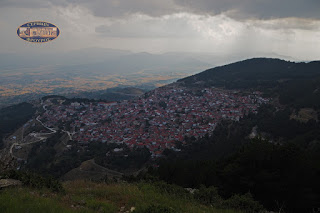 |
| Thessaloniki, ancient roman ruins |
~ Για ελληνικά:
The appearance of Aromanians [1], Latin-speaking ones, Vlachs [2], known more widely as Koutsovlachs [3], in north Greece territories dates back to the Roman conquest. This fact has been recognized by distinguished and special Romanian scientists such as Vasile Pârvan, Radu Vulpe, Gheorghe Brătianu [6], Take Papahagi [7], Emile Petrovici [8], Şextil Puşcariu [9] and Dumitru Maniu [10] eventually great Th. Capidan [11] has recognized it, too. Latey, not only Aromanians’ indigenousness but their greekness have been proved after interdisciplinary converging elements, too [12]. Competent Greek scientists have already accepted (the theory) of direct or indirect linguistic enlatinization of Greek people, while a similar possibility was earlier excluded because of the superiority of Greek culture over the Roman one [14]. It is well known that Romans, before being rulers of Greek territories, had sought to establish friendly relations with Greek cities and federations [15]. When they conquered Greece [16], not having the necessary manpower to govern the new countries, they first addressed to the ruling class of Greeks to use it for the state administration, the army and other levels of state and social life. At the same time they used every Greek element [17]. Besides, Greeks of all classes did not mean to abandon their numerous activities, in particular commerce [18], exploitation of transport means [19], execution of public works, etc. The social rise of Greek urban (mainly) class in Roman Empire was indeed significant, given the fact that Greeks became senators, others occupied the office of Roman Supreme and many of them became senior military and imperial administrative officers [20]. At the same time, Greeks of lower classes, people of mountains and lowlands, were the inexhaustible source of the manning of roman legions [21], where they distinguished themselves or at least they secured better living conditions.
Greeks took care on time to obtain the title of Roman citizen [22] because this title offered special privileges and it favored social development and proficiency without obstacles in trade and other profitable professions. Indicatively, we give a few examples:
From the island of Kos, brothers Gaius Stertinius Xenophon (doctor and secretary of Emperor Claudius) and Tiberius Claudius Cleonimus (military officer of Roman army). From the town of Mytilene Marcus Pompeius Macrinus (roman supreme). From the town of Ephesus Tiberius Julius Celsus Polemius, supreme, his son Tiberius Julius Akylas Polemius, also supreme, who founded the famous library in his hometown. From the town of Nicomedia, the well-known writer Flavius Arrianus, provincial governor and supreme. From the city of Pergamon, the history writer Avlos Claudius Harax, commander of roman legion and supreme. From the island of Limnos the well-known writer Flavius Philostratus, whose son was called Lucius Flavius Capitoleinus. From the island of Crete, Lefkius Flavius Sulpikianus (Dorion Polyknis), senator. From the town of Sparta Gaius Julius Euriklis, cashier, mayor, general and senator. From Athens, Marcus Ulpius Eviotis, supreme, and his sons Marcus Ulpius Flavius Tisamenus and Marcus Ulpius Pupinius Maximus. Also Herod Atticus, whose full name is Tiberius Claudius Herod Atticus Marathonius. From the town of Megara Komodos Komodou. From the island Amorgos Aurelius Octavius, Aurelius Ermeus’ son. Plutarch's nephew, stoic philosopher and Marcus Aurelius’ teacher, Sextus, and others. Consequently, as Ioannis Touloumacus also writes, “from the presence of Greeks in the Senate, the administration and the army of the Empire, one would also expect cultural influences - and of course, first of all in language. All Greek officers of the Roman Empire knew latin language pretty much, some even so good as to read latin classic writers comfortably, too. In fact, Latin was known by almost all Greek intellectuals of the Roman era, from Polybius and Posidonius (during the period of liberty) to Plutarch and Philostratus, during the imperial period [23]”.





